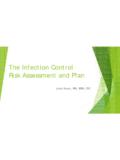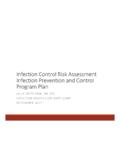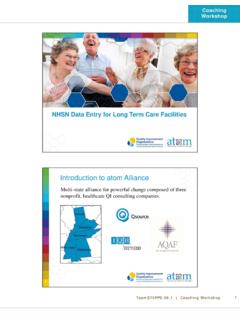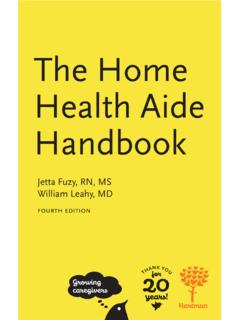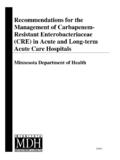Transcription of Andrea Flinchum, MPH, BSN, CIC Healthcare …
1 Andrea Flinchum, MPH, BSN, CIC. Healthcare -Associated Infection Prevention Program Manager Division of Epidemiology and Health Planning Infection Prevention Boot Camp September 26, 2017. Objectives Describe the components of the Infection Control Assessment Response (ICAR) tool Discuss common ICAR findings in Kentucky facilities and how they can be used to develop interventions aimed at improving the Infection Prevention and Control Program 2. ICAR. Developed by centers for disease Control and Prevention (CDC).
2 Used to assist health departments in assessing infection prevention practices Guide quality improvement May also be used by Healthcare facilities to conduct internal quality improvement audits 3. Settings Tool was developed for the following settings: Acute Care Hospitals Long Term Care Outpatient Settings Hemodialysis Facilities 4. Acute Care Hospitals Overview Section 1: Facility Demographics Section 2: Infection Control Program and Infrastructure Section 3: Direct Observation of Facility Practices (Optional).
3 Section 4: Infection Control Guidelines and Other Resources 5. Facility Demographics 6. Domains for Gap Assessment Infection Control Program and Infrastructure Infection Control Training, Competency, and Implementation of Policies and Practices Systems to Detect, Prevent, and Respond to Healthcare -Associated Infections and Multidrug-Resistant Organisms (MDROs). 7. Infection Control Program and Infrastructure 8. Kentucky Results Infection Control Program and Infrastructure ACH - 69% (n=9) No gaps in domain LTACH - 100% (n=3) At least one gap in domain Critical Access Hospitals 100% (n=1) No gaps in domain 9.
4 Infection Control Training, Competency, and Implementation of Policies and Practices 10. Sub-Domains Hand Hygiene Personal Protective Equipment Prevention of Catheter-associated Urinary Tract Infection (CAUTI). Prevention of Central Line-associated Bloodstream Infection (CLABSI). Prevention of Ventilator-associated event (VAE). Injection Safety Prevention of Surgical Site Infection (SSI). Prevention of Clostridium difficile infection (CDI). Environmental Cleaning Device Reprocessing 11. Kentucky Results Hand Hygiene ACH 54% (n=7) No gaps in domain LTACH - 33% (n=1) No gaps in domain Critical Access Hospitals 100% (n=1) At least one gap in domain Hospitalhas a competency-based training program for hand hygiene Personnel are required to demonstrate competency with hand hygiene following each training 12.
5 Kentucky Results Personal Protective Equipment (PPE). ACH 23% (n=3) No gaps in domain LTACH - 100% (n=3) At least one gap in domain Critical Access Hospitals 100% (n=1) At least one gap in domain Hospital has a competency-based training program for use of PPE. Personnel are required to demonstrate competency with selection and use of PPE ( correct technique is observed by trainer) following each training. 13. Kentucky Results Prevention of CAUTI. ACH 100%(n=13) At least one gap in domain LTACH - 100% (n=3) At least one gap in domain Critical Access Hospitals 100% (n=1) At least one gap in domain Hospital has a competency-based training program for insertion of urinary catheters Training is provided at least annually Hospital has a competency-based training program for maintenance of urinary catheters Personnel are required to demonstrate competency with catheter maintenance ( correct technique is observed by trainer)
6 Following each training 14. Kentucky Results Prevention of CLABSI. ACH 85% (n=11) At least one gap in domain LTACH - 100% (n=3) At least one gap in domain Critical Access Hospitals 100% (n=1) At least one gap in domain Hospital provides feedback from audits to personnel regarding their performance for management of ventilated patients Hospital routinely audits (monitors and documents). adherence to recommended practices for management of ventilated patients ( suctioning, administration of aerosolized medications).
7 15. Kentucky Results Prevention of VAE. ACH 92% (n=12) At least one gap in domain LTACH - 100% (n=3) At least one gap in domain Critical Access Hospitals - Not applicable Hospital has a competency-based training program for insertion of central venous catheters Training is provided at least annually/Hospital routinely audits (monitors and documents) adherence to recommended practices for insertion Hospital has a competency-based training program for maintenance of central venous catheters Respondent can describe how feedback is provided/frequency of feedback 16.
8 Kentucky Results Injection Safety ACH 100% (n=13) At least one gap in domain LTACH - 67% (n=2) At least one gap in domain Critical Access Hospitals - 100% (n=1) At least one gap in domain Hospital routinely audits (monitors and documents). adherence to safe injection practices Hospital has a drug diversion prevention program that includes consultation with the IP program when drug tampering (involving alteration and substitution) is suspected or identified to assess patient safety risks. 17. Kentucky Results Prevention of SSI.
9 ACH 69% (n=9) At least one gap in domain LTACH - 67% (n=2) Not applicable Critical Access Hospitals - 100% (n=1) No gaps in domain Hospital routinely audits (monitors and documents). adherence to recommended infection control practices for SSI prevention 18. Kentucky Results Prevention of CDI. ACH 77% (n=10) At least one gap in domain LTACH - 100% (n=3) At least one gap in domain Critical Access Hospitals - 100% (n=1) No gaps in domain Hospital has specific antibiotic stewardship strategies in place to reduce CDI.
10 Hospital educates patients and family members about the risk of CDI with antibiotics 19. Kentucky Results Environmental Cleaning ACH 62% (n=8) At least one gap in domain LTACH - 100% (n=3) At least one gap in domain Critical Access Hospitals - 100% (n=1) No gaps in domain Hospital has policies that clearly define responsibilities for cleaning and disinfection of non-critical equipment, mobile devices, and other electronics ( ICU monitors, ventilator surfaces, bar code scanners, point-of-care devices, mobile work stations, code carts, airway boxes).
